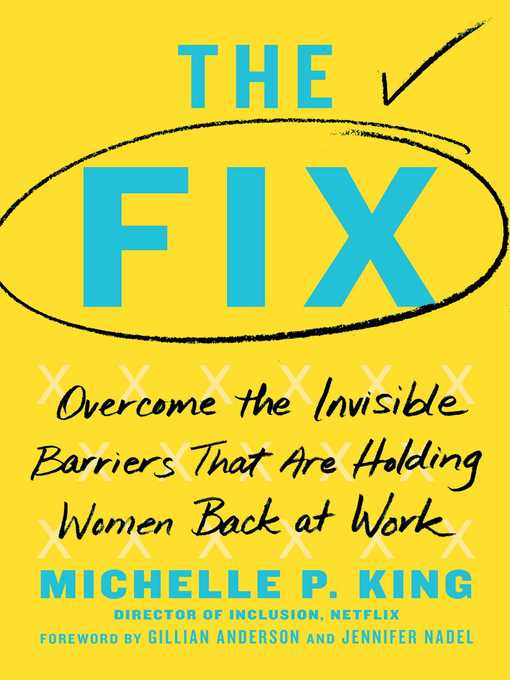
The Fix
Overcome the Invisible Barriers That Are Holding Women Back at Work
- اطلاعات
- نقد و بررسی
- دیدگاه کاربران
نقد و بررسی

January 1, 2020
A global expert on organizational diversity and inclusion explains how to create an equitable workplace. King is head of the U.N. Women's Global Innovation Coalition for Change and an advisory board member for Girl Up, a campaign by the United Nations Foundation that helps fund and support programs that focus on adolescent girls. She is also a keynote speaker, researcher, and writer as well as the host of a weekly podcast, The Fix, in which she shares ways men and women "can advance equality at work." In her debut book, King challenges the notion of the ideal worker and condemns the success prototype common in traditional workplace environments. While the author acknowledges that strides have been made, she contends that organizations, often unknowingly, "operate in a way that marginalizes, excludes, or devalues women." She also contends that many organizations do not value differences and that their "diversity and inclusion efforts" are often "aimed at fixing women" rather than creating a workplace that truly supports men and women equally. Backed by extensive research data and interviews with company and thought leaders, the book is divided into three primary sections. In Part I, King explores the history of the workplace and the challenges faced by both women and men in this conventional environment. In Part II, she identifies three career phases common for women and the "invisible barriers" that women typically face at each stage. In Part III, the author provides a call to action for employees and leaders to begin discussing these hidden barriers and implementing changes that create environments and cultures that support everyone in an organization. Throughout the book, King also calls out problems and identifies specific ways employees and leaders can begin fixing them. Although the text is particularly geared toward issues faced by women, the author rightly asserts that equality in the workplace will benefit everyone. A common-sense guidebook for creating a workplace that values men and women equally.
COPYRIGHT(2020) Kirkus Reviews, ALL RIGHTS RESERVED.

January 13, 2020
King, head of the UN Women’s Global Innovation Coalition for Change, debuts with a welcome addition to the growing chorus of voices calling out the system rather than individual women for workplace gender inequity. She asks why people are obsessed with the idea that women need to be fixed, despite being more likely to have the characteristics commonly associated with good leaders—being collaborative, communicative, and well-educated. To her, the answer lies in an outdated expectation of what constitutes the “ideal worker”: a stereotypically masculine, aggressive, and family-deprioritizing man, an ideal she associates with Mad Men’s Don Draper character. King writes about how privilege and denial keep inequality going, how men are also harmed by gender assumptions, how feminism hasn’t gone far enough, and how working mothers and female leaders still struggle with stereotypes and institutional barriers. The challenge, she shows, is in getting people to understand there’s a problem at all, but King is there with strategies for taking action—she calls “for breaking up with Don” and critically reexamining how ideas about masculinity play out in the workplace. This thoughtful, thorough, often enraging look at a broken system delivers a resounding and memorable message: “Women are not the problem.”

March 6, 2020
King (director of inclusion, Netflix) shows how women continue to face barriers at work. Women are not the problem, King maintains. Rather, the workplace was designed for and continues to favor men. Based on interviews with employees at various corporations, the book is divided into three parts. The first section, "Awareness," focuses on the causes of gender inequality in organizations, and details the visible and invisible barriers preventing women from advancing as well as the role of toxic masculinity and office politics. In the second segment, "Understanding," King examines the challenges women face throughout their careers: the idealistic years of entering the workforce; the middle years, balancing work and home life; and veteran years, when women want to contribute meaningfully, but their leadership might be undermined in male-dominated environment. Lastly, "Action," discusses what steps need to be implemented in order to promote gender equality, and how readers can take steps to remove workplace barriers. King includes case studies gleaned from her research to illustrate these issues and possible solutions. VERDICT With forewords by Gillian Anderson and Jennifer Nadel, this inspirational, thought-provoking guide is highly recommended for women at all stages in their careers.--Lucy Heckman, St. John's Univ. Lib., Queens Village, NY
Copyright 2020 Library Journal, LLC Used with permission.

February 15, 2020
It is exhausting to hear researchers and authors dump issues about gender equality in the workplace at the feet of women themselves. Failure is due to, they claim, any number of individual issues, from nonconformity to lack of awareness about corporate dos and don'ts. Nonsense. It is the fault of the workplace, an environment designed by men, for men. Consultant King more than proves her point with case histories and statistics documenting the invisible barriers women face: the confidence-versus-competence catch-22. The penalties ladled out to moms who adopt part-time work. Even the so-called standard of success (which she calls "the Don Draper syndrome"). Though King touts the fix throughout, there is no one panacea, nor any one way to ensure equality. And unfortunately, the last section, on how to act to change the workplace, falls flat when she simply looks at awareness and understanding of barriers, with action afterwards, as the fix. Detailed roadmaps, please; otherwise, it will take at least another century to realize a 50-50 balance in the C-suite.(Reprinted with permission of Booklist, copyright 2020, American Library Association.)




دیدگاه کاربران